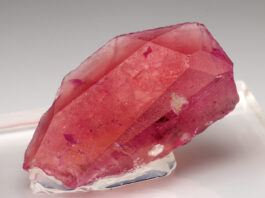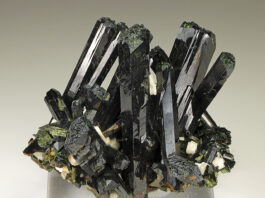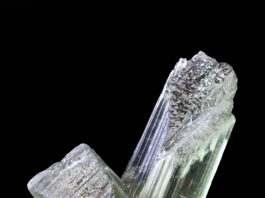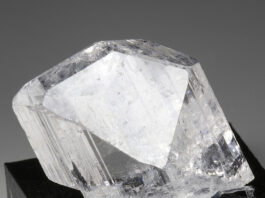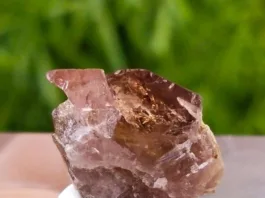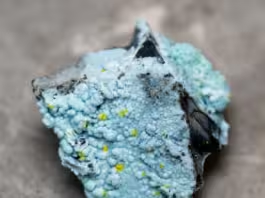

Ilmenite, otherwise called manaccanite, is a titanium-iron oxide mineral with formula: FeTiO3. It is a noteworthy wellspring of titanium. Typically thick and tabular, its crystals sometimes occur as thin lamellae (fine plates) or rhombohedra.. It can also be massive, or occur as scattered grains. Intergrowths with hematite or magnetite are common, and ilmenite can be mistaken for these minerals because of its opaque, metallic, gray-black color. Unlike magnetite, however, ilmenite is nonmagnetic or very weakly magnetic; and it can be distinguished from hematite by its black streak. It may weather to a dull brown color. It is widely distributed as an accessory mineral in igneous rocks, such as diorite and gabbro. It is a frequent accessory in kimberlite rocks, associated with diamond. It is also found in veins, pegmatite rocks, and black beach sands associated with magnetite, rutile, zircon, and other heavy minerals.
Name: For the early-noted occurrence in the Il’men Mountains, Russia.
Association: Magnetite, hematite, rutile, ulv¨ospinel, pyrrhotite, apatite
Polymorphism & Series: Forms three series, with ecandrewsite, with geikielite, and with pyrophanite.
Mineral Group: Ilmenite group
Crystallography: Rhombohedral; trigonal-rhombohedral. Crystals usually thick tabular with prominent basal planes and small rhombohedral truncations. Faces of the third order rhombohedron rare. Crystal constants close to those for hematite. Often in thin plates. Usually massive, compact; also in grains or as sand.
Ilmenite Composition: Ferrous titanate, FeTi03. Fe = 36.8 per cent, Ti = 31.6 per cent, O = 31.6 per cent. By the introduction of ferric oxide, the ratio between the titanium and iron often varies widely. The excess of ferric oxide may be largely due to minute inclusions of hematite. Magnesium may replace the ferrous iron.
Diagnostic Features: It can be distinguished from hematite by its streak and from magnetite by its lack of magnetism. In doubtful cases, as in intergrowths with magnetite, it is necessary to apply the chemical tests.
Contents
Chemical Properties
| Chemical Classification | Oxide mineral |
| Formula | Fe2+TiO3 – Fe2+Ti4+O3 |
| Common Impurities | Mn,Mg,V |
Ilmenite Physical Properties
| Color | Iron black or black |
| Streak | Black to reddish brown |
| Luster | Metallic, Sub-Metallic |
| Cleavage | None Observed |
| Diaphaneity | Opaque |
| Mohs Hardness | 5 – 6 |
| Crystal System | Trigonal |
| Tenacity | Brittle |
| Density | 4.68 – 4.76 g/cm3 (Measured) 4.789 g/cm3 (Calculated) |
| Fracture | Conchoidal, Sub-Conchoidal |
| Morphology | Commonly thick tabular {0001}. Sometimes in thin laminae; also acute rhombohedral. Compact massive; as embedded grains. |
| Other characteristics | weakly magnetic |
Ilmenite Optical Properties
| Type | Anisotropic |
| Anisotropism | Strong in shades of gray |
| Color / Pleochroism | Weak |
| Twinning | {0001} simple, {1011} lamellar |
| Optic Sign | Uniaxial (-) |
| Birefringence | Strong O=pinkish brown E= dark brown |
Occurrence of Ilmenite
Ilmenite comes in the form of layers and lens bodies wrapped in gneiss and other crystal metamorphic rocks. Common in veins or large masses as a product of magmatic segregation. Associated with magnetite. Also as an accessory mineral in igneous rocks. One component of black sand associated with magnetite, rutile, zircon and monasite. Found in large numbers in Kragero and other settlements in Norway; in crystals at Miask in the Ilmen Mountains, USA Found in the United States in Washington, Connecticut; in Orange County, New York and with many magnetite deposits in the Adirondack region. Also on Bay St. to find Paul in Quebec
Uses Area
As a wellspring of titanium for paint shade. Can’t be utilized as an iron mineral as a result of troubles in purifying it. In addition, a modest quantity present in a magnetite body renders it of little incentive as a metal.
It is the essential mineral of titanium metal. Limited quantities of titanium joined with specific metals will create sturdy, high-quality, lightweight combinations. These compounds are utilized to produce a wide assortment superior parts and instruments.
Models include: flying machine parts, counterfeit joints for people, and donning hardware, for example, bike outlines. About 5% of the ilmenite mined is utilized to create titanium metal. Some ilmenite is additionally used to create engineered rutile, a type of titanium dioxide used to deliver white, very intelligent shades.
The vast majority of the rest of the ilmenite is utilized to make titanium dioxide, a dormant, white, exceptionally intelligent material. The most significant utilization of titanium dioxide is as a whiting. Whitings are white, exceedingly intelligent materials that are ground to a powder and utilized as shades. These shades produce a white shading and splendor in paint, paper, glues, plastics, toothpaste, and even sustenance.
Titanium dioxide is additionally used to make powders with a firmly controlled molecule size range. These powders are utilized as modest cleaning abrasives in an assortment of lapidary work that incorporates shake tumbling, lapping, cabbing, circle making, and faceting. Titanium oxide abrasives are utilized in numerous different businesses.
Varieties of Ilmenite (Mindat.com)
| Cr-rich Picroilmenite | A cromium- and magnesium-rich variety of ilmenite, containing up to 8.6% Cr2O3 and up to 17.0% MgO. |
| Ferrian Ilmenite | containing up to 33% Fe2O3 in solid-solution in the rhombohedral series Fe2O3-FeTiO3. |
| Guadarramite | A supposed radioactive variety of ilmenite |
| Hystatite | A ferrian variety of ilmenite. On material from Arendal. |
| Iserine | A supposed cubic form of ilmenite. |
| Originally described from Jizerská meadow (Iser meadow), Jizerské Mts (Iser Mts), Liberec Region, Bohemia (Böhmen; Boehmen), Czech Republic. | |
| Kibdelophane | A high Ti |
| Magnesian Chromian Ilmenite | A Mg-Cr-bearing variety from DeBeers mine (kimberlites), associated, i.a., with hawthorneite. |
| Magnesian Menaccanite | A magnesian variety of ilmenite. |
| Magnesian ilmenite | A variety of ilmenite with some Mg replacing Fe2+. |
| Magnetoilmenite | A ferrian variety of ilmenite. |
| Manaccanite | A ferrian variety. [Clark, 1993 – “Hey’s Mineral Index”] |
| Originally reported from Tregonwell Mill, Manaccan, Lizard Peninsula, Cornwall, England, UK. | |
| Manganilmenite | A manganian variety of ilmenite. |
| Manganoan Ilmenite | manganese-bearing variety of ilmenite. The pure Mn end-member is pyrophanite. |
| Picrocrichtonite | A magnesian variety of ilmenite. |
| Picroilmenite | A Mg-rich variety of ilmenite. |
| Picrotitanite | A magnesian variety of ilmenite. |
Distribution
Widespread; well-crystallized from numerous localities.
- In the Vishnevy-Il’men Mountains, Southern Ural Mountains, Russia, large crystals; from the Lovozero massif, Kola Peninsula.
- In Norway, at Tellnes and Snarum; large crystals from Kragerøand Arendal. From Binntal, Valais, Switzerland.
- At St. Cristophe, Bourg d’Oisans, Isere, France.
- In the USA, at Quincy, Norfolk Co., Massachusetts; from Litchfield, Litchfield Co., Connecticut; large crystals from the Lake Sanford area, Essex Co., New York.
- At Allard Lake, Quebec; Bancroft, Ontario; and elsewhere in Canada.
- From Arkaroola Bore, Flinders Ranges, and near Bimbowrie, South Australia.
References
- Bonewitz, R. (2012). Rocks and minerals. 2nd ed. London: DK Publishing.
- Dana, J. D. (1864). Manual of Mineralogy… Wiley.
- Handbookofmineralogy.org. (2019). Handbook of Mineralogy. [online] Available at: http://www.handbookofmineralogy.org [Accessed 4 Mar. 2019].
- Mindat.org. (2019): Mineral information, data and localities.. [online] Available at: https://www.mindat.org/ [Accessed. 2019].
 English
English Español
Español Français
Français Deutsch
Deutsch Italiano
Italiano Português
Português Türkçe
Türkçe Nederlands
Nederlands Русский
Русский 한국어
한국어 Čeština
Čeština Polski
Polski Ελληνικά
Ελληνικά 简体中文
简体中文
